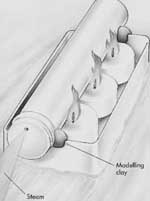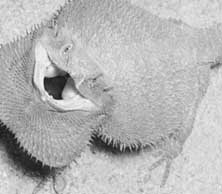 |
 26th April 1998 |
Front Page| |
|

|
|||
Make a Steam Boat
1. Place the three candles inside the tin. 2. Pour about 2cm (3/4 inch) of water into the metal tube. Ask an adult to help you make a small hole in the screw cap of the tube and put the cap on the tube. 3. Use modelling clay to fix the metal tube inside the sardine tin, over the candles. 4. Put the steam boat in the bath or in a pool of water where there is plenty of space. 5. Light the candles and watch the boat travel. Warning : Make sure you blow out the match and the candles afterwards. How it works: As the candles heat the water in the tube, it boils and turns to steam. The steam shoots out of the hole in the tube and pushes the boat forward. STAMP NEWS 13A new ParliamentBy Uncle DCRThe new Parliament complex at Sri Jayawardenapura Kotte is one of the most picturesque sights in the outskirts of Colombo. Sixteen years ago, on April 29, 1982, the new complex was opened by President J. R. Jayewardene. The occasion was marked with the issue of a 50 cent stamp depicting an aerial view of the complex. The need for a new Parliament arose when it was realised that with the
increase in the number of Members of Parliament (MPs) there was not enough
accommodation in the old Parliament at Galle While the need to build a new complex was being discussed from the early 1970s, it was after the Jayewardene Government was set up in July 1977 that it was decided to locate the new Parliament at a suitable site in Kotte. An island in the historic Diyawanna Oya was chosen. The reputed architect Geoffrey Bawa was selected to design it. The Japanese firm Mitsui Ltd was chosen as the builders. The site chosen was a marsh. It was dredged to form a large man-made lake with a wide shore, later to be thickly wooded with indigenous trees. The new Parliament buildings stand on this island and the approach is across a great causeway and forecourt to the bronze doors in the entrance arcade. Then up the ceremonial stairs leading through the silver doors to the central core of power - the Chamber - within the main pavilion with its balconies and galleries, rises three storeys above the two levels of tiered terraces within which are the administrative offices and committee rooms. The huge copper roofs of the pavilions, large and small, supported by the traditional patterns of timber and stone columns have an echo of the monastic and royal buildings of the distant past. The lobby walls are decked with murals painted by Dr. Manjusri, the famous Sri Lankan painter. Banners and Standards used in ancient times adorn the Chamber. The new Parliament has brought back the glory that Sri Jayawardenapura Kotte once enjoyed as the country's capital (1411 to 1568). Parakramabahu VI founded the Kotte kingdom giving it supremacy over the subject kingdoms in the country. His 55 year reign was a golden era of poetry and literature. With the advent of the Portuguese (1505) resulting in constant harassment, the kingdom was shifted fro m Kotte to Udarata (Kandy) and in 1597 the city was finally abandoned and its temples, buildings and monuments were razed to the ground by the Portuguese. Opening the new Parliament complex, President Jayewardene said: "In this Temple of Democracy let us so conduct ourselves for the welfare of the many that generations yet unborn may say that within this Chamber our words and conduct represented our finest hours."
Part 1Animal CharacteristicsThe animal king dom includes hundreds of thousands
of different types of creatures. They range in size from microscopic single-celled
creatures at one end of the scale to giant blue whales at the other. This is why there is such a tremendous variety of life forms within the animal kingdom. But however unlike two types of animal may seem, they always have several characteristics in common which make them animals and not plants. Animal movement Perhaps the most obvious difference between plants and animals is that animals can move about. Plants are literally "rooted to the spot", but animals can travel through water or air or over land. There are, however, one or two exceptions. The barnacle, for example, usually remains in one spot for the whole of its adult life. Other animals, such as jellyfish, depend mainly on sea currents to carry them from one place to another. Many animals can swim, but they do not all swim in the same way. Fish and whales propel themselves forward, by their powerful tails. Smaller sea-dwelling animals swim in the water by waving ''cilia" which are hair-like structures along their bodies. Some animals can fly. Nearly all the known species of insects can fly and most birds fly too. Bats are the only mammals that have true wings and can fly. But the most usual way animals move about is by walking. Advanced vertebrates (animals with backbones) usually have very strong muscular legs which are excellent for walking. Amphibians have legs which are less well adapted for walking on land. Frogs, for example, cannot walk or run but they can jump superbly well by using their long hind legs. Slugs and snails do not have limbs. They only have a single fleshy foot and they pull themselves along. Many animals are not restricted to one method of getting about. Ducks, for example, can fly, swim and walk. |
|||
 |
Return to Mirror Magazine Contents
|
||
 |
Please send your comments and suggestions on this web site to |
||
 Equipment:
A clean sardine tin, three thin slices of candle, water, a hollow metal
tube ( such as the one used to hold some indigestion tablets), modelling
clay.
Equipment:
A clean sardine tin, three thin slices of candle, water, a hollow metal
tube ( such as the one used to hold some indigestion tablets), modelling
clay.  Face.
Over the years, the number of MPs had steadily increased. The State Council
(1931-1947) had 61 members (50 elected, 8 nominated by the Governor &
3 Officers of State - the Chief Secretary, the Financial Secretary &
the Legal Secretary). When the House of Representatives replaced the State
Council in 1947, there were 101 MPs - 95 elected & 6 appointed by the
Governor-General. The number increased to 157 (151 elected & 6 appointed)
in 1960 and to 168 in 1977. From 1989 the number has risen to 225 (196
electd & 29 nominated from the National List.)
Face.
Over the years, the number of MPs had steadily increased. The State Council
(1931-1947) had 61 members (50 elected, 8 nominated by the Governor &
3 Officers of State - the Chief Secretary, the Financial Secretary &
the Legal Secretary). When the House of Representatives replaced the State
Council in 1947, there were 101 MPs - 95 elected & 6 appointed by the
Governor-General. The number increased to 157 (151 elected & 6 appointed)
in 1960 and to 168 in 1977. From 1989 the number has risen to 225 (196
electd & 29 nominated from the National List.)  Animals
can be found in almost any environment — at the bottom of the sea, on the
top of a mountain, in hot deserts or Arctic wastelands. Over millions of
years, each type of animal has evolved its own life-style to suit its particular
environment.
Animals
can be found in almost any environment — at the bottom of the sea, on the
top of a mountain, in hot deserts or Arctic wastelands. Over millions of
years, each type of animal has evolved its own life-style to suit its particular
environment.